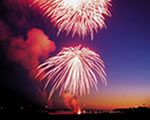 Go to main content
Go to main content
Archive Website of the UK government
Please note that this website has a UK government accesskeys system.
Main menu
Page menu
Home and community

Organising a firework display

If you are organising a firework display, make sure everyone involved knows what they are doing to avoid any accidents. Find out about your responsibilities to the public and the people working with you when organising a firework display.
Planning a firework display
When you are planning a firework display, set up a committee with each person taking responsibility for a particular task. Try to have at least one person with experience of organising a firework display and make sure everyone understands firework safety.
Make sure everyone has a copy of the Health and Safety Executive’s guide ‘Giving your own firework display’ which you can also order.
Who to contact about your firework display
Contact the following organisations well in advance to let them know your plans for the firework display:
- the local fire and rescue service
- the police
- first aid organisations, like the St John Ambulance, to arrange for a manned first aid post
- your local council - check whether you need a licence
- the Coastguard, if your display is taking place within five miles of the coast
You should also contact people in the area who may need to prepare for a firework display, like farmers, stables and dog kennels. Older people living alone or in sheltered accommodation may also appreciate advance warning, so the noise doesn’t come as a shock.
It’s helpful to have one person in charge of contacting all the organisations involved.
Firework display checklist
As well as contacting and speaking with all the organisations involved, you and your team will need to:
- organise having the fireworks delivered and stored safely
- warn neighbours so that they can keep pets indoors
- borrow or hire special clothing, like fluorescent jackets, to identify you and your team on the night
- get a public address system - a loud hailer will do as a minimum - to give any instructions, eg to evacuate the area in an emergency
- arrange for fire extinguishers, metal litter bins and buckets of water and sand to be available on the night
- have plenty of torches with full batteries
- let people know that spectators will not be allowed to bring their own fireworks, including sparklers
- make up all necessary signs
- make sure you have enough people to help on the night, including some extra people to cover anyone who falls ill
- check whether your insurance covers any firework-related injuries – look for a company that’s used to insuring public events
Pick a suitable location
Choose a large, clear, well-mown area away from buildings, trees and hazards, like overhead cables. As a minimum, you’ll need an area:
- of at least 50 metres by 20 metres to let off the fireworks
- of 100 metres by 50 metres behind this in the downwind direction for the ‘dropping zone’ (where the fireworks land) – check the weather forecast beforehand
- 25 metres from the firing area on the opposite side to the dropping zone for the spectators
You should consider cancelling the display in very windy weather.
Make sure you have as many safe, well-lit and sign-posted exits and entrances as possible. These must be away from the firing and drop zone.
Keep the car parking area well away from your display and dropping zone. It should be signposted clearly with a separate entrance to the pedestrian access.
Keeping control of the crowd
Proper crowd control is essential to prevent accidents. You will need to:
- have one steward for every 250 spectators
- make sure your stewards know what to do in an emergency
- keep spectators out of the display and dropping zones
- beware of overcrowding and follow police advice
Handle fireworks with care
Make sure you know how to handle and set off your fireworks in advance of the display. For more information, see ‘Firework safety and the law’.
After the event
When the event is over, make sure you have plenty of people to help:
- clear spectators away from the site
- put the bonfire out completely - if you have one
- gather the spent firework cases with suitable tools, like tongs - wear strong gloves and don’t let children help
If any fireworks look as if they haven’t gone off, soak them in water for at least half an hour. If necessary, you can call the Fire Service for advice.
 Facebook
Facebook Twitter
Twitter StumbleUpon
StumbleUpon Delicious
Delicious Reddit
Reddit
